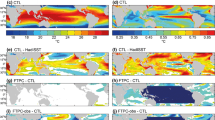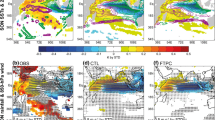Abstract
The role of the Indonesian Throughflow (ITF) in the influence of the Indian Ocean Dipole (IOD) on ENSO is investigated using version 2 of the Parallel Ocean Program (POP2) ocean general circulation model. We demonstrate the results through sensitivity experiments on both positive and negative IOD events from observations and coupled general circulation model simulations. By shutting down the atmospheric bridge while maintaining the tropical oceanic channel, the IOD forcing is shown to influence the ENSO event in the following year, and the role of the ITF is emphasized. During positive IOD events, negative sea surface height anomalies (SSHAs) occur in the eastern Indian Ocean, indicating the existence of upwelling. These upwelling anomalies pass through the Indonesian seas and enter the western tropical Pacific, resulting in cold anomalies there. These cold temperature anomalies further propagate to the eastern equatorial Pacific, and ultimately induce a La Niña-like mode in the following year. In contrast, during negative IOD events, positive SSHAs are established in the eastern Indian Ocean, leading to downwelling anomalies that can also propagate into the subsurface of the western Pacific Ocean and travel further eastward. These downwelling anomalies induce negative ITF transport anomalies, and an El Niño-like mode in the tropical eastern Pacific Ocean that persists into the following year. The effects of negative and positive IOD events on ENSO via the ITF are symmetric. Finally, we also estimate the contribution of IOD forcing in explaining the Pacific variability associated with ENSO via ITF.
Similar content being viewed by others
References
Alexander, M. A., I. Blade, M. Newman, J. R. Lanzante, N. C. Lau, and J. D. Scott, 2002: The atmospheric bridge: The influence of ENSO teleconnections on air-sea interaction over the global oceans. J. Climate, 15, 2205–2231.
Allan, R. J., and Coauthors, 2001: Is there an Indian Ocean dipole and is it independent of the El Niño-Southern Oscillation? International CLIVAR Project Office, 18–22.
Annamalai, H., S. P. Xie, J. P. McCreary, and R. Murtugudde, 2005: Impact of Indian Ocean sea surface temperature on developing El Niño. J. Climate, 18, 302–319.
Baquero-Bernal, A., M. Latif, and S. Legutke, 2002: On Dipolelike variability of sea surface temperature in the tropical Indian Ocean. J. Climate, 15, 1358–1368.
Behera, S. K., J. J. Luo, S. Masson, S. A. Rao, H. Sakuma, and T. Yamagata, 2006: A CGCM study on the interaction between IOD and ENSO. J. Climate, 19, 1688–1705.
Chen, D., M. A. Cane, A. Kaplan, S. E. Zebiak, and D. Huang, 2004: Predictability of El Niño over the past 148 years. Nature, 428, 733–736.
Clarke, A. J., and S. Van Gorder, 2003: Improving El Niño prediction using a space-time integration of Indo-Pacific winds and equatorial Pacific upper ocean heat content. Geophys. Res. Lett., 30, 1399, doi: 10.1029/2002GL016673.
Danabasoglu, G., and Coauthors, 2011: The CCSM4 ocean component. J. Climate, 25, 1361–1389.
Deser, C., and Coauthors, 2012: ENSO and Pacific decadal variability in the community climate system model version 4. J. Climate, 25, 2622–2651.
Diaz, H. F., M. P. Hoerling, and J. K. Eischeid, 2001: ENSO variability, teleconnections and climate change. International Journal of Climatology, 21, 1845–1862.
Hong, C.-C., T. Li, and J.-J. Luo, 2008a: Asymmetry of the Indian Ocean dipole. Part II: Model diagnosis. J. Climate, 21, 4849–4858.
Hong, C.-C., T. Li, L. Ho, and J.-S. Kug, 2008b: Asymmetry of the Indian Ocean dipole. Part I: Observational analysis. J. Climate, 21, 4834–4848.
Izumo, T., M. Lengaigne, J. Vialard, J. J. Luo, T. Yamagata, and G. Madec, 2014: Influence of Indian Ocean Dipole and Pacific recharge on following year’s El Niño: Interdecadal robustness. Climate Dyn., 42, 291–310.
Izumo, T., and Coauthors, 2010: Influence of the state of the Indian Ocean Dipole on the following year’s El Niño. Nature Geoscience, 3, 168–172.
Jin, E., and Coauthors, 2008: Current status of ENSO prediction skill in coupled ocean-atmosphere models. Climate Dyn., 31, 647–664.
Jochum, M., B. Fox-Kemper, P. H. Molnar, and C. Shields, 2009: Differences in the Indonesian seaway in a coupled climate model and their relevance to Pliocene climate and El Niño. Paleoceanography, 24, PA1212, doi: 10.1029/2008PA001678.
Kug, J. S., and I. S. Kang, 2006: Interactive feedback between ENSO and the Indian Ocean. J. Climate, 19, 1784–1801.
Large, W. G., and G. Danabasoglu, 2006: Attribution and impacts of upper-ocean biases in CCSM3. J. Climate, 19, 2325–2346.
Latif, M., and Coauthors, 1998: A review of the predictability and prediction of ENSO. J. Geophys. Res.:-Oceans, 103, 14375–14393.
Lau, N.-C., and M. J. Nath, 2003: Atmosphere-Ocean Variations in the Indo-Pacific Sector during ENSO Episodes. J. Climate, 16, 3–20.
Lee, T., and Coauthors, 2010: Consistency and fidelity of Indonesian-throughflow total volume transport estimated by 14 ocean data assimilation products. Dyn. Atmos. Oceans, 50, 201–223.
Luo, J.-J., S. Masson, S. K. Behera, and T. Yamagata, 2008: Extended ENSO predictions using a fully coupled ocean-atmosphere model. J. Climate, 21, 84–93.
Luo, J.-J., R. Zhang, S. K. Behera, Y. Masumoto, F.-F. Jin, R. Lukas, and T. Yamagata, 2010: Interaction between El Niño and Extreme Indian Ocean Dipole. J. Climate, 23, 726–742.
Meng, W., and G. X. Wu, 2000: Gearing between the Indian and Pacific Ocean (GIP) and the ENSO, Part 2. model simulation. Chinese Journal of Atmospheric Sciences, 24, 15–25. (in Chinese)
Meyers, G., R. J. Bailey, and A. P. Worby, 1995: Geostrophic transport of Indonesian Throughflow. Deep-Sea Research Part I-Oceanographic Research Papers, 42, 1163–1174.
Nagura, M., and M. Konda, 2007: The seasonal development of an SST anomaly in the Indian Ocean and its relationship to ENSO. J. Climate, 20, 38–52.
Nicholls, N., W. Drosdowsky, and A. M. S. Ams, 2001: Is there an equatorial Indian Ocean SST dipole, independent of the El Niño-Southern Oscillation? Climate Variability, the Oceans, and Societal Impacts, The The 81st AMS Annual Meeting, Albuquerque, NM, U.S., January 2001, 17–18.
Roxy, M., S. Gualdi, H. K. L. Drbohlav, and A. Navarra, 2011: Seasonality in the relationship between El Niño and Indian Ocean dipole. Climate Dyn., 37, 221–236.
Saji, N. H., and T. Yamagata, 2003: Structure of SST and surface wind variability during Indian Ocean dipole mode events: COADS observations. J. Climate, 16, 2735–2751.
Schott, F. A., S. P. Xie, and J. P. McCreary Jr., 2009: Indian ocean circulation and climate variability. Rev. Geophys., 47, doi: 10.1029/2007RG000245.
Shinoda, T., W. Han, E. J. Metzger, and H. E. Hurlburt, 2012: Seasonal Variation of the Indonesian Throughflow in Makassar Strait. J. Phys. Oceanogr., 42, 1099–1123.
Tippett, M. K., A. G. Barnston, and S. Li, 2011: Performance of recent multimodel ENSO forecasts. J. Appl. Meteor. Climatol., 51, 637–654.
Wang, B., R. G. Wu, and X. H. Fu, 2000: Pacific-East Asian teleconnection: How does ENSO affect East Asian climate?. J. Climate, 13, 1517–1536.
Wu, G., and W. Meng, 1998: Gearing between the Indian and Pacific Ocean (GIP) and the ENSO, Part 1. Data analyses. Chinese Journal of Atmospheric Sciences, 22, 470–480. (in Chinese)
Wyrtki, K., 1987: Indonesian through flow and the associated pressure gradient. J. Geophys. Res.: Oceans, 92, 12941–12946.
Yuan, D. L., and Coauthors, 2011: Forcing of the Indian Ocean Dipole on the interannual variations of the tropical Pacific Ocean: Roles of the Indonesian Throughflow. J. Climate, 24, 3593–3608.
Yuan, D. L., H. Zhou, and X. Zhao, 2013: Interannual climate variability over the tropical Pacific Ocean induced by the Indian Ocean Dipole through the Indonesian Throughflow. J. Climate, 26, 2845–2861.
Author information
Authors and Affiliations
Corresponding author
Rights and permissions
About this article
Cite this article
Zhou, Q., Duan, W., Mu, M. et al. Influence of positive and negative Indian Ocean Dipoles on ENSO via the Indonesian Throughflow: Results from sensitivity experiments. Adv. Atmos. Sci. 32, 783–793 (2015). https://doi.org/10.1007/s00376-014-4141-0
Received:
Revised:
Accepted:
Published:
Issue Date:
DOI: https://doi.org/10.1007/s00376-014-4141-0




